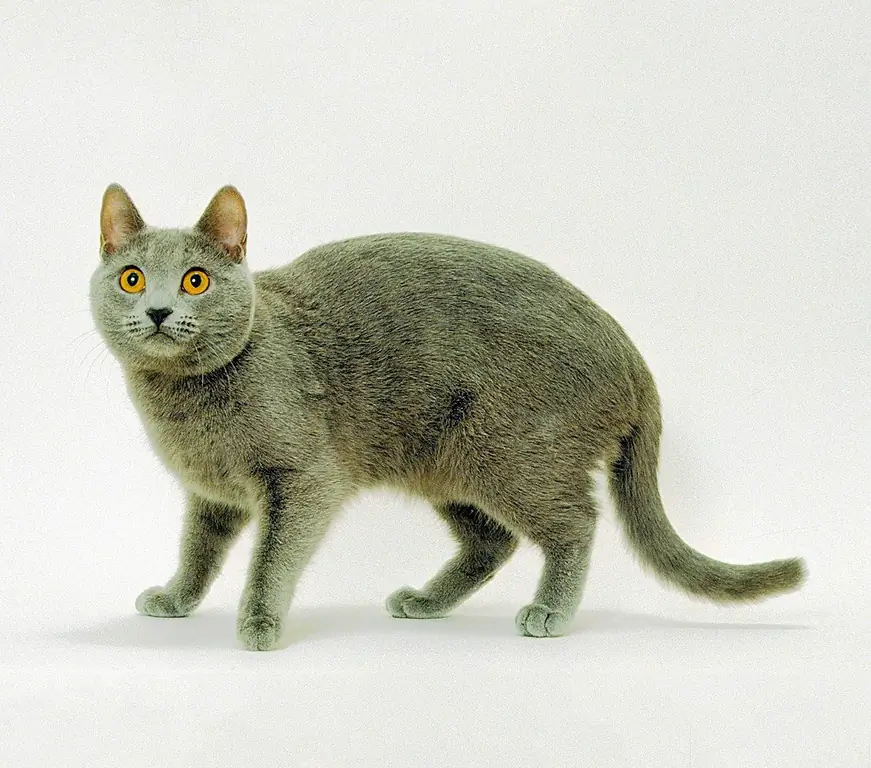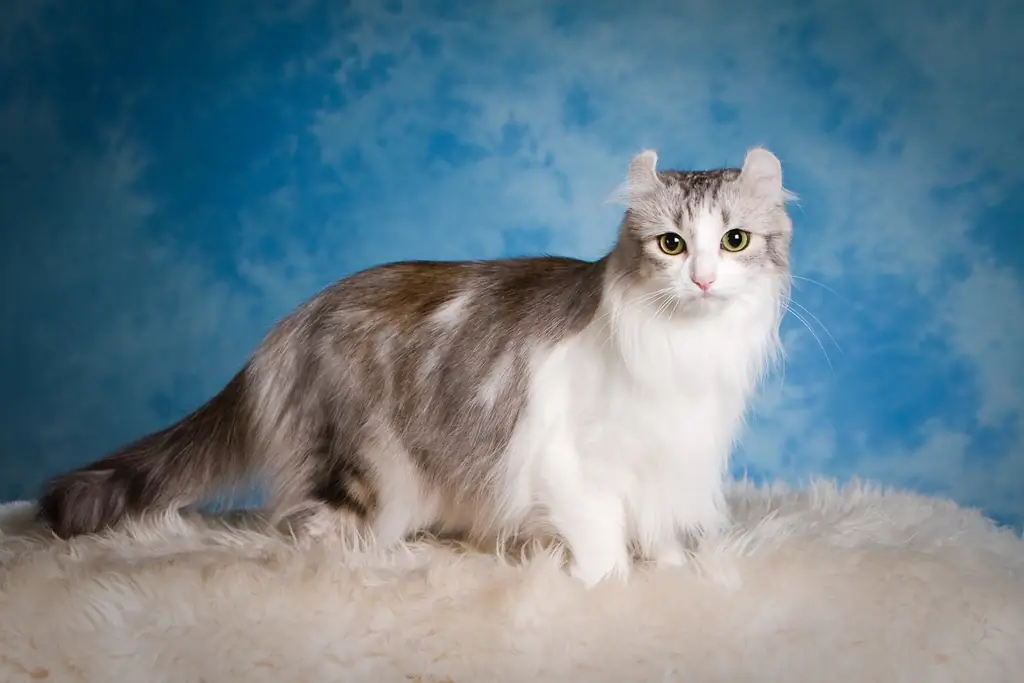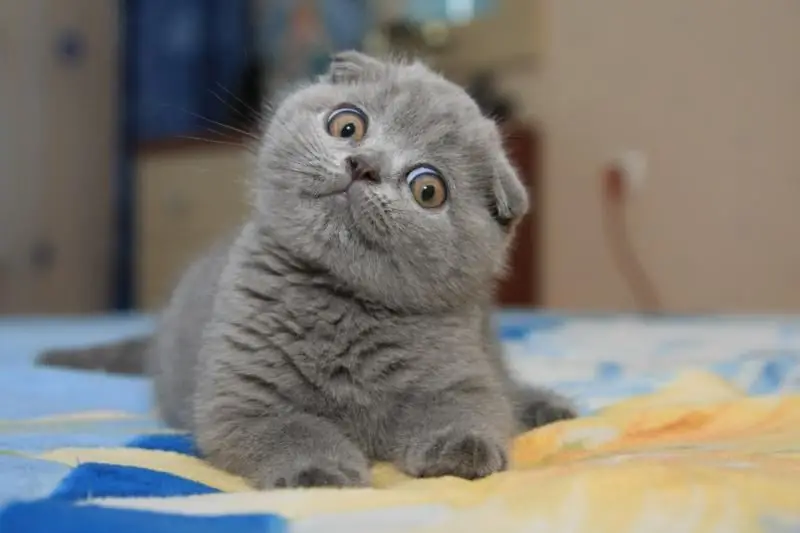
Table of contents:
- Author Bailey Albertson [email protected].
- Public 2024-01-17 22:26.
- Last modified 2025-06-01 07:32.
Plebeians of the feline world: features of keeping outbred purrs

Modern cats are the descendants of the once domesticated wild animals that live on all continents of the Earth. Before a man began to deliberately breed the purr of the desired colors, distinguishing animals into breeds and classes, simple "Vaseks" were loved for their ability to exterminate rodents and unpretentious care. To this day, mongrel cats are valued for their good health, and such pets participate in exhibitions together with their pedigree relatives.
Content
-
1 There are many of them and they are in "vests"
1.1 Photo gallery: typical types of colors of a mongrel cat
-
2 How mongrel cats behave
2.1 Video: an exhibition of outbred cats
- 3 Domestic cat health
-
4 Content features
- 4.1 Video: how to take care of a domestic cat
- 4.2 How to feed a mongrel cat
-
5 Where to find a mongrel kitten
5.1 Video: how to choose the right kitten
- 6 Owner reviews
There are many of them and they are in "vests"
Non-breed cats make up almost 90% of the purring world population. Tamed by the ancient Egyptians, these animals faithfully serve people to this day.

Outbred cats are the most numerous representatives of their kind
Since the purr was loved not only in the Nile Valley, but all over the globe, in different parts of the planet the domus (as felinologists call domestic outbreds) over time began to look their own way.
At present, experts refer to ordinary fluffies living in apartments either as a street breed (a cross of several breeds, in the formation of which humans no longer participated), or as a street aboriginal (when yard cats descend from wild local purrs). The latter are subdivided into the following varieties:
- Celtic cats (European shorthair);
- siamese cats;
- angora cats;
- persian cats;
- Siberian cats.
Initially, people were not engaged in the selection of street fuzzies, therefore, among these purrs, there are both blue-eyed and green-eyed handsome men. The tails of mestizo cats can be either long or short, which is also true for the ears and for the body as a whole.
The appearance of mongrel cats is formed under the influence of the habitat and climate. So, northern murkas are distinguished by their massive constitution and long hair with a thick undercoat. And on the southern shores, graceful and slender seals with short, easily blown fur are more common. And the weight of smooth-haired domus is no more than 6 kg.

The length of the coat of street cats depends on the climate
The specificity of the origin also leaves an imprint on the process of pigmentation of the coat of a mongrel cat. Among the representatives of the species, there are both spotted purrs and monochromatic ones. The color palette is amazing with its diversity - here you can find ginger cats, black and gray, and even happy tricolor cats.
Thus, despite the unflattering name, a beautiful and graceful animal with an unusual fur coat and bright eyes may well grow from a simple street kitten. The main thing is to show proper care and attention to him.
Photo gallery: typical types of colors of a mongrel cat
-

A tortoiseshell mongrel cat lies on the rug and looks up -
Tortoiseshell color is not uncommon among mongrel cats
-

Black cat with yellow eyes lies on its side - Black street cats are agile night hunters
-

Ginger cat sits with ears pressed to his head and squinting - Ginger cats have long been considered defenders against witchcraft
-

A gray striped cat without breed stands on mossy stones - The gray color of the fur coat is the perfect way to disguise
-

Tricolor cat sits in autumn foliage - Tricolor cats are a good luck charm for many pet lovers
-

White cat stretches while standing on the pavement -
White cats are the rarest among outbreds
How mongrel cats behave
In mongrel purrs, the characters differ as much as their appearance. Everything here is like in people - it is impossible to predict in advance what disposition a newborn kitten will have in the future.

Outbred cats are distinguished by their independent disposition
If a kid is picked up right from the street, a loyal and affectionate pet will grow from such a "mongrel". The animal saved from hunger and cold will retain a grateful attitude to the owner and his family members for life.
Growing up, a cat that does not belong to any breed can please the owner with such qualities:
- lack of hidden grudges and desire to take revenge;
- indifference to the owner's furniture and flowers;
- love of life and a positive attitude.
In general, mongrel cats behave non-aggressively, they are quite calm and flexible. However, this does not mean that all the courtyards are gentle and affectionate. There are also such wayward "personalities" who will not let anyone near them. Among the domus there are both phlegmatic "lazybones" and sports-looking "activists".
An interesting feature of non-breed catofees is the ability to quickly memorize commands, which is due to the high level of intelligence of this group of felines. Therefore, simple domestic cats are very easy to train to the toilet and even teach simple (and, if desired, not so) tricks.
Like many human-raised animals, mongrel purrs do not tolerate separation from their owner and can even become depressed or depressed. Therefore, you should not leave your pet alone for a long time, and in case of forced business trips, it is better to acquire a "companion" for the fluffy. And although at first conflicts are not excluded between the pets, after a week or two the tailed beasts will find a common language and make friends.
Video: show of outbred cats
Domestic cat health
Common yard cats have long been prized by pet lovers for their good health and the absence of genetic diseases, which pedigree purrs often cannot boast of. This feature was formed for centuries in the wild and remained with the cats even after they settled under the same roof with a person.

Domestic cats are renowned for their good health
Good immunity becomes the basis for a long and interesting life for mongrel cats. After all, old age in these animals begins by 8-9 years, and the average life expectancy is 10-12 years. Often there are also long-livers, "holding out" up to 16-17 years of age.
However, in matters of the health of domus, some features should be taken into account:
- if there were pedigree individuals among the ancestors of the pet, then you should be prepared for the manifestation of hereditary ailments;
- the tolerance of drugs is strictly individual and it is very difficult to predict the consequences of anesthesia or exposure to other drugs.
Outbred cats are not protected from typical "street" sores - ringworm, helminths and fleas. Therefore, after getting into the house of the yard kitten, you must definitely go with the baby to the veterinarian and save the fluffy from such misfortunes.
And to ensure your beloved mustache a long and happy life, it is important to get vaccinated regularly. Moreover, after one year of age, the vaccine needs to be done only once a year.
Features of the content
As a rule, simple domestic cats do not require special care skills and are able to take care of their appearance on their own.
Despite the "street" origin, the cleanliness of mongrel purrs can only be envied. As true representatives of their kind, domusi carefully monitor the condition of the fur coat and the sharpness of the claws. Therefore, the house must have a special scratching post. Also, the owner should regularly trim the pet's claws with special tweezers or a nail clipper.
The rest of the maintenance of a mongrel cat includes the following points:
- washing no more than once every six months, and for long-haired ones - monthly;
- eye cleaning - every 1-2 days;
- ear cleansing - weekly;
- dental calculus prophylaxis and teeth cleaning - once a week.
In addition, seals with long hair need to be combed weekly, and during the autumn and spring molting, the procedure should be carried out daily. Thanks to such careful care, mats do not form on the purr fur coat, and the skin will not become inflamed and itchy.
Walks in the fresh air are also of great importance for yard mustache. Therefore, in the case of living in a city apartment without free access to the street, it is better to teach a cat from childhood to a harness and a leash.

Outbred cats - lovers of long walks
The fluffy should be walked away from highways and asphalt paths, so that the animal can walk on soft grass and breathe in the scents of nature. It is also recommended to avoid places for walking dogs, as the latter can scare the cat and "discourage" her from leaving the walls of her home.
Video: how to care for a domestic cat
What to feed a mongrel cat
When deciding to get a purebred purr, nutritional issues come to the fore, because "noble" catofees are distinguished by a sensitive and gentle digestive system. The situation is different with simple courtyard mustache.

You can feed mongrel cats either with food or natural food
The ancestors of simple domus hunted mice and small birds, which provided their descendants with a strong stomach, capable of digesting almost all edible products. It is clear that it is unacceptable to give alcohol and soda to cats, but a caring owner will in any case make sure that his pet's diet is correct.
And here's what else you need to know about feeding mongrel cats:
- you can not mix ready-made industrial feed and natural food;
- if the cat eats "natural", you should add vitamins and minerals to the menu;
- include cartilage and other solid foods in the diet for the prevention of tartar (or buy special bones at a pet store);
- long-haired murkas should be given a special herb to remove swallowed wool from the stomach.
In addition, you should not drink raw milk for homemade catofee, because the consequences of using such a dish are diarrhea and indigestion. Feeding with spices, fried, salted and smoked foods, chips, pasta and sweets also leads to the latter.
To avoid health problems in a pet, it is better to give preference to such products:
- fresh and cooked meat (beef, chicken);
- fish without bones (preferably sea);
- boiled and stewed vegetables (zucchini, carrots);
- low-fat dairy products (kefir, sour cream, cottage cheese);
- boiled chicken eggs (or, alternatively, quail eggs);
- greens (lettuce, dill).
In matters of nutrition, mongrel cats are not always picky - there are both fastidious and "gluttons". Therefore, the mustache should be fed twice a day in portions of 150-200 g. Veterinarians recommend feeding the fluffy food at the same time - this way the nutrients will be better absorbed. Kittens, on the other hand, have food bowls filled four times a day up to 6 months of age.
A prerequisite for a healthy diet for a mongrel cat is the round-the-clock availability of clean drinking water and the absence of contamination in the food bowl.
Where to find a mongrel kitten
Despite the apparent simplicity and obviousness of the answer to the question of how to acquire a simple domus, there can be several options for getting a kitten without a breed into the house:
- it is clear that the easiest and, moreover, free method will be to pick up a purr right on the street - in this case, you need to immediately take the animal to a veterinary clinic for examination;
-
for thrifty animal lovers, there is also an option with viewing advertisements for the transfer of the offspring of a domestic cat "into good hands" for free or for a nominal fee;

Striped brown kitten lies on the couch and looks up You can often buy mongrel kittens by advertising "in good hands"
- and for those who are looking for a pet with an unusual and noble appearance, you can contact the nurseries of thoroughbred animals, because culled individuals are often born there - such babies are sold several times cheaper than those that meet the standards of relatives, which pleases potential owners a lot, moreover, from those taken in professional clubs kittens already have the necessary vaccinations and even a pedigree.
Important points to pay attention to when choosing a kitten you like from a private person or in a cattery:
- the cat should be cheerful and inquisitive, not scared or attack;
- the baby's fur should be clean and fluffy, without scraps and bald spots;
- the seller must keep the ears, nose and eyes of the animal clean;
- the belly of the purr cannot be too swollen, which means that the fluffy has worms;
- an unpleasant odor should not come from the pet's mouth, indicating diseases of the teeth and digestive tract.
The best age for acquiring a purebred kitten from hands or from breeders is considered to be 2.5-3 months old. At this time, the baby begins to wean from breast milk and socialize. Therefore, getting into a new family will be perceived by a fluffy without unnecessary stress and deterioration in health.
Video: how to choose the right kitten
Owner reviews
Outbred cats are valued by many lovers of domestic animals, including for their kind attitude towards children and even sometimes for their ability to alleviate diseases.

Outbred cats are loyal and wise pets
According to the author, a mongrel cat is one of those domestic animals that are brought up not for “status” or earnings, but for “soul”. And if the cat is also picked up from the street, in general we can talk about an attempt to save the cat population on a small scale. The answer to such a truly human attitude towards animals will be kindness on the part of a cat, a periodic desire to eat and purr on your knees. Street cats are cautious and intelligent pets that do not cause trouble for the owner, hardly get sick and even drive away rodents if they appear in the house.
Outbred cats are the most popular purrs since the time of the ancient Egyptians, due to the strong immunity and docile nature of these tailed "smaller brothers". In addition, such a fluffy miracle can be purchased only by leaving the house or by calling on the announcement of the transfer of the animal as a gift.
Recommended:
Cartesian Cat Chartreuse: Breed Description, Character And Upbringing, Maintenance And Care, Photos, Owner Reviews

Where is the Chartreuse breed of cats bred, what are the main external differences, what character it has, how to properly care for the breed, how to choose a kitten
American Curl: External Features Of The Breed, Care And Maintenance, Character Of The Cat, Choice Of A Kitten, Owner Reviews, Photos

Where the American Curl breed was bred. The main external differences, character traits. Rules of care and feeding. Tribal work. Owner reviews
York Chocolate Cat: Description Of Appearance, Character And Behavior, Care And Feeding, Breed Photos, Owner Reviews

Where is the breed bred, what are the main external differences, what character does the York chocolate cat have, how to properly care for and feed it
Anatolian Cat: Features Of The Breed's Appearance, Care And Maintenance Of The Cat, Character And Habits, Breeding Pets, Owner Reviews

Where the Anatolian breed is bred. The main external differences, the nature of the pet. How to properly care for him, feed him. How to choose a kitten. Breeding. Reviews
British Fold Cat: Breed Features, Description Of The Character And Behavior Of The British, Photos, Choice Of A Kitten, Owner Reviews

History of the British Fold. Description of appearance and character. Diseases of the breed. The choice of the Fold Briton. Maintenance and feeding of British Folds. Breeding
